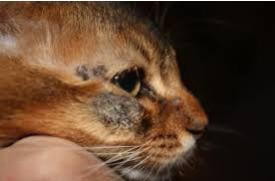
Ringworm is not really a “worm.”
"Ringworm" is the common name given to a fungal infection of the superficial layers of the skin, hair and nails. Ringworm infections can occur in humans and in all domesticated species of animals. The name comes from the classical appearance of the round, red, raised 'ring' marking the boundary of inflammation in people infected with the disease. The common name of ringworm is somewhat misleading, in that it is not an infection caused by a worm, and the infected areas can be flaky and greasy rather than circular.
The most common cause of ringworm is a type of dermatophyte, called Microsporum canis this species is infectious to cats, dogs and man. The medical term for ringworm is dermatophytosis. People who live in environments where ringworm spores are concentrated, like catteries, can develop ringworm lesions on their skin.
Ringworm can be disguised as something else
Ringworm can be challenging to detect in cats, since the lesions of ringworm may be very mild or even undetectable. Many cats diagnosed with “allergies” will actually be infected with ringworm fungi. Ringworm fungi feed on a protein called keratin that is found in the dead outer layers of the skin, hair and nails. Scaling in the depths of the hair coat may be the only visible indicator of ringworm infection in cats. Some cats may have round thickened patches of skin with hair loss. Hair loss (alopecia) occurs when the spores infect the hair shafts, resulting in broken hairs. In cats, the main sites for these lesions are the skin on the head, chest, forelegs and along the ridge of the back. These lesions are not usually itchy. Occasionally, infection of the claws known as onychomycosis may occur. The claws become rough, pitted, and develop a scaly base; they may ultimately become deformed. Ringworm may sometimes cause a more generalized disease where a much larger area of the body is affected, often seen as patchy hair loss. Some cats, especially longhaired breeds, may have ringworm without any clinical signs or hair loss. This condition is known as an asymptomatic carrier state. These cats may infect other animals or people, especially in shelter or multi-cat environments, without caregivers suspecting they may be infected.
Ringworm is highly contagious
Ringworm is contagious and transmission occurs by direct contact with the fungus or the spores. It may be passed by direct contact with an infected animal or person, or by handling contaminated objects or touching contaminated surfaces. The fungal spores may remain dormant on combs, brushes, food bowls, furniture, bedding, carpet or other environmental surfaces for many months (reportedly up to 18 months). Spores may be killed with a solution of chlorine bleach and water (one pint of chlorine bleach (500 ml) in a gallon of water (4 liters), or a dilution of 1:10 to 1:100), where it is feasible to use it. Contact with ringworm fungus does not always result in an infection. The amount of environmental contamination is an important factor in the development of a ringworm infection, as is the age of the exposed person or animal. Healthy adult humans usually are resistant to infection unless there is a break in the skin such as a scratch. Elderly people, young children, and adults with immune system weaknesses or skin sensitivities are especially susceptible to ringworm infection. The incubation period between exposure to ringworm fungus and the development of ringworm lesions usually ranges from seven to fourteen days; some cases may take up to 21 days before signs of infection develop. How is a ringworm infection diagnosed? The majority of cases of feline ringworm caused by M. canis will glow with a yellow-green fluorescence when the skin and coat are examined in a dark room under a special ultraviolet lamp called a Wood's lamp. However, not all cases show clear fluorescence and some other dermatophytes like Trychophyton mentagrophytes do not fluoresce. Some skin ointments and other materials will fluoresce and may give a false positive result. Wood's Lamp Showing Fluorescense on a Cat's nose infected with ringworm The preferred method for diagnosing ringworm in cats is by culture of the fungus in a laboratory. For this, samples of hair and skin scrapings are taken. A positive culture can sometimes be confirmed within a couple of days, but in some cases the fungal spores may be slow to grow, and culture results can take up to four weeks, meaning that a suspected case cannot be called negative for at least a month.
